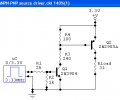I wanted some help in designing Darlington transistor pair... application is : i should use it in one of the microcontroller's output port to basically source more current.... i have VCC=3.3v... current drawn frm darlington can be around few uA n output can be around 50 to 100mA... how do i proceed ? also should i put base to emitter resistor ?










